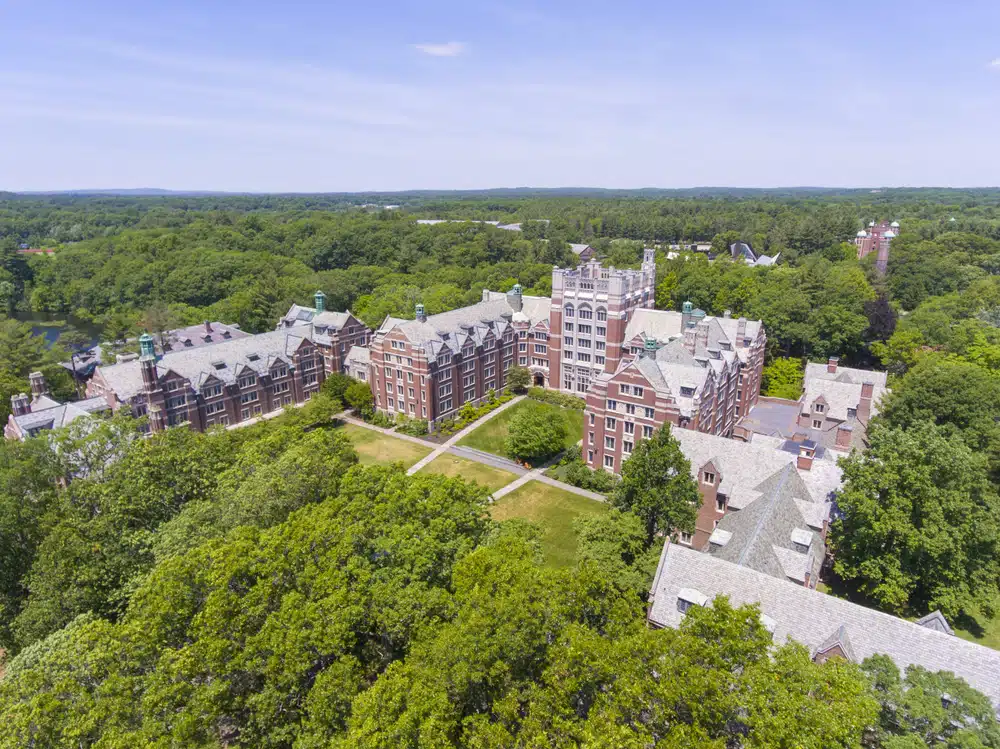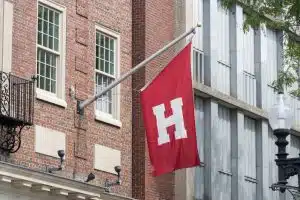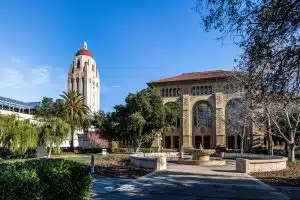Wellesley Acceptance Rate: Admissions Statistics
Wellesley College, one of the most prestigious liberal arts colleges in the United States, boasts a competitive acceptance rate of 13%.
What is Wellesley’s Acceptance Rate?
Wellesley’s acceptance rate is a significant factor that potential applicants consider when deciding whether to apply. With an acceptance rate of just 13%, gaining admission to Wellesley is highly competitive. This means that out of every 100 applicants, only around 13 are accepted.
However, it’s important to note that while Wellesley’s acceptance rate may appear low, it indicates the college’s selective admissions process. Wellesley seeks to admit students who demonstrate exceptional academic abilities and the potential to contribute to the campus community.
Applicants to Wellesley should not be discouraged by the low acceptance rate but rather inspired to showcase their unique qualities and dedication to learning.
While Wellesley’s acceptance rate may be low, the college takes a holistic approach to admissions. Admissions officers carefully review each application, considering factors such as academic achievements, extracurricular involvement, personal essays, and letters of recommendation. The college values students who are academically accomplished and demonstrate a passion for learning and a commitment to making a positive impact.
Wellesley’s acceptance rate of 13% reflects the college’s selective admissions process and its commitment to admitting students who demonstrate exceptional academic abilities and potential for contributing to the campus community. While the acceptance rate may be low, it should not discourage potential applicants but inspire them to showcase their unique qualities and dedication to learning. Wellesley College offers a transformative educational experience, empowering women to become influential leaders in their fields.
Wellesley College Early Action and Early Decision Acceptance Rates
| Class | ED |
| 2027 | no data |
| 2026 | no data |
| 2025 | 23.5% |
| 2024 | 22.8% |
| 2023 | 21.9% |
Trends in Wellesley’s Acceptance Rates
Over the years, Wellesley’s acceptance rate has experienced fluctuations. It is essential to understand these trends to gain insight into the college’s admissions process. In recent years, the acceptance rate at Wellesley has remained relatively stable, hovering around 13%. This consistency demonstrates the college’s commitment to maintaining a diverse and highly talented student body. Wellesley strives to attract students who excel academically and contribute to the vibrant campus culture.
| Year | Applicants | Admittees | Acceptance Rate |
| 2022-2023 | 8,400 | 1,092 | 13% |
| 2021-2022 | 8,700 | 1,131 | 13% |
| 2020-2021 | 7,920 | 1,267 | 16% |
| 2019-2020 | 6,627 | 1,259 | 19% |
| 2018-2019 | 6,488 | 1,204 | 14% |
One factor that has contributed to the stability of Wellesley’s acceptance rate is the college’s rigorous admissions process. The admissions committee carefully evaluates each applicant’s academic achievements, extracurricular involvement, and personal qualities. They seek students with impressive academic records who demonstrate a genuine passion for learning and a commitment to positively impacting the world.
Wellesley’s commitment to diversity is another reason the acceptance rate has remained consistent. The college values students from various backgrounds, cultures, and perspectives, as they believe that a diverse student body enriches the learning environment and fosters a sense of inclusivity. Admissions officers seek out students who can contribute unique experiences and perspectives to the Wellesley community.
It is worth noting that while the acceptance rate alone cannot guarantee success in gaining admission, understanding the trends in acceptance rates can help applicants gauge their competitiveness and better prepare their applications.
For prospective students, it is crucial to consider that the acceptance rate is just one aspect of the admissions process. Wellesley College looks beyond numbers and statistics when evaluating applicants. They consider the whole person, their personal qualities, leadership potential, and ability to contribute to the college community.
Additionally, Wellesley College offers a holistic approach to admissions, considering factors such as an applicant’s essays, recommendation letters, and demonstrated interest in the college. They want to ensure that admitted students have the academic qualifications and align with the college’s values and mission.
Furthermore, Wellesley College is committed to providing its students with a supportive and nurturing environment. The college offers various resources and programs to help students succeed academically, socially, and personally. From academic advising to career development services, Wellesley College aims to empower its students to thrive during college and beyond.
While the acceptance rate at Wellesley College has remained relatively stable, it is important to recognize that the admissions process is multifaceted and considers various factors beyond the acceptance rate. Prospective students should emphasize their unique qualities, experiences, and aspirations in their applications to increase their chances of admission to this esteemed institution.
Wellesley Admissions Statistics
Looking deeper into Wellesley’s admissions statistics provides a more comprehensive understanding of the applicant pool and the college’s criteria for selection.
Each year, Wellesley receives thousands of applications from highly qualified candidates. The admissions office evaluates these applications holistically, considering academic achievements, extracurricular involvement, leadership experience, and personal qualities. It is vital for applicants to present a well-rounded profile that showcases their strengths in these areas.
In addition to an impressive academic transcript, the admissions committee looks for students who demonstrate intellectual curiosity, a passion for learning, and a desire to impact the world positively.
Wellesley College, known for its rigorous academics and commitment to empowering women, attracts a diverse pool of applicants worldwide. The college’s reputation for excellence in the liberal arts and its strong emphasis on empowering women to become leaders in their fields make it a highly sought-after institution.
For the Class of 2027, Wellesley College received over 8,400 first-year applications and admitted 1,138 students, resulting in an acceptance rate of 13%. The admitted class is diverse, with 64% being domestic students of color, 23% being first-generation college students, and 11% being international citizens. The students hail from 46 states, the District of Columbia, Guam, Puerto Rico, and 33 countries outside the United States.
The admissions committee carefully considers the applicant’s academic achievements when reviewing applications. This includes evaluating the rigor of the courses taken, the grades earned, and any honors or awards received. However, the committee also recognizes that academic performance is just one aspect of a student’s potential. They value intellectual curiosity, critical thinking skills, and a genuine love for learning.
Extracurricular involvement is another important factor in the admissions process. Wellesley College values students who actively engage in their communities and demonstrate leadership potential. Whether it’s through participating in student government, leading a club or organization, or volunteering in the local community, applicants who can showcase their ability to make a positive impact outside of the classroom are highly regarded.
Personal qualities and character traits also significantly influence the admissions decision. Wellesley College seeks students with resilience, empathy, and a commitment to social justice. They want to admit individuals who will contribute to the vibrant and inclusive community on campus and go on to make a difference in the world.
While the admissions process at Wellesley is rigorous, the college ensures a fair evaluation of every application, providing equal opportunities for all qualified candidates. The admissions committee considers the unique circumstances and challenges that applicants may have faced, recognizing that a student’s potential cannot be solely determined by their academic record.
As a result, Wellesley College can assemble a diverse and talented student body, comprising individuals from various backgrounds, cultures, and perspectives. This diversity enriches all students’ academic and social experiences, fostering a vibrant and inclusive campus community.
SAT/ACT Scores for Wellesley Admits
The SAT and ACT scores of admitted students at Wellesley reflect the college’s commitment to academic excellence. Wellesley College prides itself on its rigorous academic standards. As such, the college significantly emphasizes standardized test scores during the admissions process.
Wellesley College temporarily suspended its standardized test (SAT/ACT) requirement for four years for applicants entering 2021, 2022, 2023, and 2024. However, for the applicants who did submit their test scores, the average SAT score composite at Wellesley is around 1433, with the 25th percentile New SAT score being 1440 and the 75th percentile SAT score being 1540. Additionally, half of the applicants admitted to Wellesley College who submitted test scores have an SAT score between 1430 and 1550 or an ACT score of 33 and 35.
It is important to remember that SAT/ACT scores are just one application component. Wellesley takes a holistic approach to evaluating applicants, considering a combination of academic, extracurricular, and personal factors.
Academic achievement is undoubtedly a crucial aspect of the admissions process but is not the sole determining factor. Wellesley College recognizes students as multidimensional individuals with diverse talents, passions, and experiences. As such, the admissions committee carefully reviews each applicant’s entire profile, considering their involvement in extracurricular activities, leadership roles, community service, and unique personal qualities.
Furthermore, Wellesley values diversity and seeks to create a vibrant and inclusive campus community. The college actively encourages applications from students of all backgrounds, recognizing the importance of different perspectives and experiences in enriching the educational environment.
Wellesley College also understands that standardized test scores may not accurately reflect a student’s potential. Factors such as test anxiety, limited access to test preparation resources, or personal circumstances can impact performance on these exams. Therefore, the admissions committee takes a nuanced approach when evaluating SAT/ACT scores, considering them in the context of the applicant’s overall academic record and personal circumstances.
Ultimately, Wellesley’s admissions process aims to identify students who not only possess exceptional academic abilities but also demonstrate intellectual curiosity, a passion for learning, and a commitment to making a positive impact in the world. The college seeks to cultivate a community of scholars who will thrive academically, contribute meaningfully to campus life, and go on to become leaders in their respective fields.
What is Wellesley looking for?
Like many highly selective institutions, Wellesley College seeks a diverse and intellectually engaged student body. While the specific criteria may vary, here are some general qualities and characteristics that Wellesley College may look for in prospective students:
- Academic Excellence:
- Wellesley seeks students who have excelled academically in a challenging high school curriculum. This includes strong performance in core subjects such as English, mathematics, science, and social studies.
- Intellectual Curiosity:
- The college values intellectually curious students who are passionate about learning and eager to explore various academic disciplines.
- Leadership and Initiative:
- Wellesley looks for students who have taken on leadership roles or shown initiative in their schools, communities, or extracurricular activities. This could include leading clubs, organizing events, or participating in community service.
- Diversity of Experiences:
- The college values diversity in all its forms, including cultural, socioeconomic, and experiential diversity. Students who bring unique perspectives, backgrounds, and experiences to campus contribute to the richness of the Wellesley community.
- Community Engagement:
- Involvement in community service, volunteer work, or engagement in activities that demonstrate a commitment to making a positive impact on the world is often considered favorably.
- Strong Writing Skills:
- Writing is an essential component of the college experience, and Wellesley looks for students with strong writing skills. This is evident in application essays and other written components of the application.
- Letters of Recommendation:
- Recommendations from teachers and counselors play a role in the admissions process. Wellesley may look for insights into a student’s academic abilities, character, and contributions to the school community.
- Passion for Gender Equity and Women’s Leadership:
- As a women’s college, Wellesley is particularly interested in applicants who are passionate about issues related to gender equity, women’s leadership, and the empowerment of women.
- Extracurricular Involvement:
- Participation in extracurricular activities, whether in the arts, sports, clubs, or other pursuits, can showcase a student’s interests, talents, and commitment outside the classroom.
- Interviews (if offered):
- While interviews are typically optional, they can provide an additional opportunity for applicants to express their enthusiasm for Wellesley, discuss their achievements, and share more about themselves.
It’s important to note that the admissions process is holistic, considering a combination of academic achievements, personal qualities, and the potential contributions a student could make to the Wellesley community. Each applicant is unique, and the admissions committee aims to understand the individual strengths and qualities of each candidate. Prospective students should carefully review the specific admissions requirements and criteria outlined by Wellesley College and present themselves authentically in their applications.
How hard is it to get into Wellesley?
Gaining admission to Wellesley is undeniably challenging due to the college’s low acceptance rate. However, it is important to approach the application process with determination, showcasing one’s unique qualities, and demonstrating a strong fit with Wellesley’s mission and values.
Applicants should aim to excel academically, actively participate in extracurricular activities, and seek meaningful experiences that align with their passions and interests. Wellesley values well-rounded individuals who excel in the classroom and contribute to the campus community through their involvement in clubs, organizations, and community service.
Wellesley’s commitment to diversity and inclusion is evident in its efforts to create a campus that embraces students from all backgrounds. The college actively seeks to enroll students who bring unique perspectives and experiences to the community, fostering a rich and dynamic learning environment.
Crafting a compelling personal statement is crucial in the application process. This is an opportunity for applicants to showcase their personal journey, aspirations, and how Wellesley can help them achieve their goals. The admissions committee looks for authenticity, resilience, and a genuine passion for learning.
Securing strong recommendation letters is another important aspect of the application. These letters provide insight into an applicant’s character, work ethic, and potential for success at Wellesley. It is advisable for applicants to choose recommenders who know them well and can speak to their strengths and abilities.
Preparing thoroughly for interviews, if offered, can also enhance an applicant’s chances of admission. Interviews allow applicants to demonstrate their communication skills, goals, and interest in attending Wellesley. Researching the college beforehand and coming prepared with thoughtful questions is important.
Ultimately, while the admissions process at Wellesley is competitive, it is important to remember that gaining admission to any college is not solely defined by the institution’s prestige but rather by finding the right fit that aligns with one’s goals and aspirations. Wellesley seeks students who will thrive academically, contribute to the campus community, and positively impact the world beyond graduation.
Wellesley Popular Programs
Wellesley College offers a broad, rigorous liberal arts education with many academic programs. Here are some popular academic areas and departments at Wellesley College:
- Economics:
- Wellesley’s Economics department explores economic theory, policy, and analysis. Students engage in coursework covering microeconomics, macroeconomics, and applied economics.
- Political Science:
- The Political Science department comprehensively studies political systems, international relations, political theory, and public policy.
- Biology:
- Wellesley’s Biology department thoroughly explores biological principles, from cellular and molecular biology to ecology and evolutionary biology.
- Psychology:
- The Psychology department covers various topics, including cognitive, developmental, clinical, and social psychology.
- Computer Science:
- Wellesley’s Computer Science department offers courses in programming, algorithms, artificial intelligence, and other areas of computer science.
- English:
- The English department comprehensively studies literature, creative writing, and critical analysis. Students explore a diverse range of literary works and genres.
- Mathematics:
- Wellesley’s Mathematics department covers a wide range of mathematical concepts, from pure mathematics to applied mathematics and statistics.
- International Relations:
- This interdisciplinary program explores global issues, international relations, and the complexities of the global political landscape.
- Environmental Studies:
- The Environmental Studies program integrates insights from the natural sciences, social sciences, and humanities to address environmental challenges.
- Women’s and Gender Studies:
- Wellesley College, focusing on women’s education, offers a strong Women’s and Gender Studies program that explores issues related to gender, sexuality, and feminism.
- Chemistry:
- The Chemistry department comprehensively studies chemical principles, laboratory techniques, and applications in various scientific fields.
- History:
- The History department covers many historical periods, regions, and themes. Students engage in critical analysis of historical events and contexts.
- Philosophy:
- Wellesley’s Philosophy department explores fundamental questions about existence, knowledge, ethics, and reality.
- Anthropology:
- The Anthropology program examines human societies, cultures, and behaviors from a cross-cultural perspective.
- Art History:
- The Art History department covers the history and analysis of art from various periods and cultures.
These academic areas provide a snapshot of the diverse range of disciplines and fields of study available at Wellesley College. Students have the flexibility to explore their academic interests, and the college encourages interdisciplinary approaches to learning. As academic offerings may evolve, checking the latest information on Wellesley College’s official website is recommended or contacting the college directly for the most up-to-date details on majors, minors, and academic programs.
How to know which major is for you
Choosing a major can be a significant decision that impacts your academic and career path. Here are some steps to help you determine which major is the right fit for you:
- Self-Reflection:
- Reflect on your interests, passions, and hobbies. Consider what subjects you enjoy studying and find intellectually stimulating. Think about activities that make you lose track of time or topics you enjoy discussing with others.
- Strengths and Skills:
- Identify your strengths and skills. What are you naturally good at? Your strengths and skills can guide you toward majors that align with your abilities and talents.
- Career Exploration:
- Explore potential careers associated with different majors. Research job prospects, industries, and the skills required for various professions. Consider talking to professionals in fields you find interesting.
- Take Introductory Courses:
- Enroll in introductory courses in different disciplines. Many universities allow students to explore a variety of subjects before declaring a major. Intro courses can provide a taste of what each major entails.
- Talk to Academic Advisors:
- Schedule meetings with academic advisors or career counselors. They can provide guidance, discuss your academic interests, and help you explore majors that align with your goals.
- Networking and Informational Interviews:
- Connect with professionals in different fields through networking events or informational interviews. Gain insights into their career paths, daily responsibilities, and the educational background required for their roles.
- Internships and Volunteering:
- Participate in internships or volunteer opportunities related to different fields. Practical experience can provide valuable insights into the day-to-day aspects of various professions.
- Consider Interdisciplinary Options:
- Explore interdisciplinary majors that combine multiple fields of study. These programs may allow you to integrate your interests and pursue a unique academic path.
- Evaluate Coursework and Requirements:
- Review the coursework and requirements for potential majors. Consider whether the classes are engaging and whether the major aligns with your long-term goals.
- Seek Guidance from Mentors:
- Seek advice from mentors, teachers, or professionals in your network. They may share their experiences, offer insights, and provide valuable advice on choosing a major.
- Personal Values and Goals:
- Consider your values and long-term goals. What kind of impact do you want to make in your career? Choose a major that aligns with your values and contributes to your life goals.
- Be Open to Change:
- Keep in mind that it’s okay to change majors. Your interests and goals may evolve as you gain exposure to different subjects and experiences.
Prospective students must explore the complete list of majors offered at Wellesley and consider their interests and career goals when choosing a major. Additionally, students often have the flexibility to pursue interdisciplinary studies and customize their academic paths.
Wellesley Admission Requirements
Wellesley College, like many selective institutions, has a comprehensive admissions process that takes into account various aspects of an applicant’s academic and personal profile:
- Application Form:
- Wellesley College accepts either the Common Application or the Coalition Application. Applicants need to choose one of these platforms to submit their application.
- Standardized Test Scores:
- Wellesley has adopted a test-optional policy, meaning that submitting standardized test scores (SAT or ACT) is not required. Students can choose whether or not to submit test scores, and this decision won’t impact the admission process.
- High School Transcript:
- Applicants must submit their high school transcripts, showcasing their academic performance and coursework throughout high school.
- Letters of Recommendation:
- Wellesley typically requires two letters of recommendation from teachers who have taught the applicant in core academic subjects.
- Essays:
- Applicants must submit essays as part of the application. These essays allow applicants to showcase their writing skills and share more about their personal experiences, interests, and aspirations.
- Extracurricular Activities:
- Information about extracurricular activities, leadership roles, and community involvement is essential to the application. Wellesley is interested in students who have demonstrated a commitment to activities outside the classroom.
- Interview (Optional):
- Interviews are optional but strongly recommended. While an interview is not required, it provides an additional opportunity for applicants to discuss their achievements, interests, and fit with Wellesley.
- Optional Supplementary Materials:
- Applicants can submit supplementary materials that showcase special talents, achievements, or interests. This could include an art portfolio, additional writing samples, or other relevant materials.
- Demonstrated Interest:
- While not a formal requirement, expressing genuine interest in Wellesley College through campus visits, interviews, or other interactions can positively impact the application.
- Application Fee Waiver:
- Wellesley College provides application fee waivers for eligible students facing financial barriers. Fee waiver requests are typically submitted through the chosen application platform.
It’s crucial for applicants to review the specific admission requirements outlined on the official Wellesley College admissions website, as these requirements may be subject to change. Additionally, contacting the admissions office with any specific questions or concerns is advisable for the most accurate and current information.
Key Application Deadlines for Wellesley
The key application deadlines for Wellesley College are as follows:
- Regular Decision:
- Application: January 8
- Wellesley-specific writing supplement: January 10
- Financial aid application: January 15
- Admission decision and financial aid notification: Late March
- Early Decision I:
- Application: November 1
- Financial Aid: November 1
- Quarter Grades: November 15
- Early Decision II:
- Application: January 1
- Financial Aid: January 1
- Quarter Grades: January 9
- Transfer Students:
- Application Due: March 1
- Supporting Materials: Within one week of the deadline
- Self-Reported Mid-Term Grades: March 25
- Financial Aid Deadline: April 1
- Decision Notification: Early May
- Reply/Deposit Deadline: June 2
- Final College Transcript: July 8
These deadlines are subject to change, so it’s important for applicants to verify them on the official Wellesley College website.
Tuition Costs at Wellesley for 2023-2024
For the 2023-2024 academic year, the tuition costs at Wellesley College are as follows:
- Tuition: $61,920 for undergraduate students
- Comprehensive Fee: $83,920 for the full academic year (including tuition, room, board, and other fees)
- Cost per Credit Hour: $1,925 for undergraduate students
Please note that these costs are subject to change, and verifying them on the official Wellesley College website is always a good idea. Additionally, the college offers financial aid and scholarships to eligible students.
When evaluating tuition costs at Wellesley College, prospective students and their families should consider several key factors. Tuition costs represent a significant aspect of the overall expense of attending college, and understanding these factors can help families plan for the financial aspects of a Wellesley education. Here are some key considerations:
- Tuition and Fees:
- The published tuition and fees are the primary costs students are expected to pay for enrollment at Wellesley College. Tuition covers the cost of instruction and academic services, while fees may include charges for specific services, facilities, or activities.
- Room and Board:
- The cost of room and board includes expenses associated with on-campus housing and dining. Wellesley typically offers various housing options, and the cost can vary based on the type of accommodation and meal plan selected.
- Financial Aid:
- Wellesley College is committed to meeting 100% of the demonstrated financial need for admitted students. Prospective students should explore the financial aid options available, including scholarships, grants, work-study opportunities, and loans.
- Merit-Based Scholarships:
- While Wellesley focuses on need-based financial aid, some merit-based scholarships may be available. These could be awarded based on academic achievements, leadership, or other exceptional talents.
- Work-Study Opportunities:
- Work-study programs allow students to work part-time on campus to earn money to help cover educational expenses. Wellesley may include work-study opportunities as part of the financial aid package.
- Additional Costs:
- Prospective students should consider additional costs such as books, supplies, transportation, and personal expenses. These costs can vary based on individual needs and spending habits.
- Net Price Calculator:
- Like many institutions, Wellesley College provides a Net Price Calculator on its website. This tool can help families estimate the net cost of attending Wellesley after factoring in financial aid and scholarships.
- Payment Plans:
- Wellesley may offer payment plans that allow families to spread the cost of tuition and other expenses over the course of the academic year. Families should inquire about available payment options.
- Financial Aid Application Process:
- Families should know the financial aid application process, including deadlines for submitting required documents. This may involve completing the Free Application for Federal Student Aid (FAFSA) and the CSS Profile.
- Understanding Financial Aid Awards:
- Once financial aid awards are provided, families should carefully review and understand the components of the award, including grants, scholarships, and loans. They should also consider the terms of any loans offered.
It’s crucial for prospective students and their families to communicate with Wellesley College’s financial aid office, utilize available resources, and plan strategically to make informed decisions about the financial aspects of attending the college. The financial aid office can provide personalized assistance and guidance throughout the process.
Wellesley Scholarships
Wellesley College is committed to meeting 100% of the demonstrated financial need for admitted students, and its financial aid program is primarily need-based rather than merit-based. While Wellesley does not offer specific “scholarships” in the traditional sense, it provides a comprehensive financial aid package that includes grants, work-study opportunities, and, if necessary, loans to help students cover college costs.
Here are key components of Wellesley’s financial aid program:
- Need-Based Financial Aid:
- Wellesley College focuses on providing financial aid based on the demonstrated financial need of admitted students. Financial aid packages are tailored to each student’s individual circumstances.
- Grants and Scholarships:
- The financial aid package typically includes grants and scholarships, which are forms of financial assistance that do not need to be repaid. These awards are intended to make Wellesley accessible to students from diverse socioeconomic backgrounds.
- Work-Study Opportunities:
- Work-study programs provide students with opportunities to work part-time on campus to earn money that can be used to help cover educational expenses. Work-study is often included as part of the financial aid package.
- Loans (if necessary):
- Students and their families may sometimes be offered loans as part of the financial aid package. Loans are typically considered after grants and scholarships, and the college aims to keep loan levels manageable.
- Financial Aid Application Process:
- To be considered for financial aid at Wellesley, prospective students must complete the necessary application forms. This may include submitting the Free Application for Federal Student Aid (FAFSA) and the CSS Profile. International students may have additional requirements.
- Need-Blind Admissions and Need-Based Aid:
- Wellesley College practices need-blind admissions, meaning that a student’s financial need does not influence the admission decision. Once admitted, the college is committed to meeting the demonstrated financial need of each student through its need-based financial aid program.
- International Student Aid:
- Wellesley is dedicated to meeting admitted international students’ full demonstrated financial need. The financial aid office works to make a Wellesley education accessible to qualified students worldwide.
It’s important for prospective students and their families to engage with the financial aid office at Wellesley College, ask questions, and seek guidance throughout the financial aid application process. The college is committed to assisting students in making Wellesley affordable and ensuring that financial considerations do not prevent qualified students from attending.
As financial aid policies and programs may evolve, it’s advisable to check the latest information on Wellesley College’s official website or contact the financial aid office for the most up-to-date details.
Student Life at Wellesley
Wellesley College offers a vibrant and engaging student life experience that goes beyond the academic setting. With a strong sense of community and various extracurricular activities, students at Wellesley can explore their interests, build lasting connections, and contribute to the rich tapestry of campus life. Here are some aspects of student life at Wellesley:
- Residential Life:
- Wellesley has a residential campus where students live in various housing options, including traditional dormitories, houses, and apartments. The close-knit residential community fosters friendships, collaboration, and a supportive environment.
- Student Organizations and Clubs:
- Wellesley boasts a diverse range of student organizations and clubs, catering to various interests and passions. Whether students are interested in academic, cultural, artistic, or athletic pursuits, there are numerous opportunities to get involved.
- Athletics and Recreation:
- The college offers a variety of sports and recreational activities for students. Whether participating in varsity sports, club sports, or intramural activities, students can engage in physical fitness, teamwork, and friendly competition.
- Cultural and Arts Events:
- Wellesley College hosts a vibrant arts and cultural scene. Students can attend concerts, theater productions, art exhibits, and other events that showcase the talents of fellow students and visiting artists.
- Community Service and Social Impact:
- Wellesley places a strong emphasis on community service and social impact. Students can engage in volunteer work, community projects, and initiatives that contribute to positive change.
- Academic Engagement:
- Beyond the classroom, students can participate in academic and intellectual activities. This includes attending lectures, discussions, and workshops that complement their coursework and foster a love for learning.
- Leadership Opportunities:
- Wellesley encourages students to take on leadership roles within the college community. Whether leading student organizations, participating in student government, or organizing events, students can develop leadership skills and make a meaningful impact.
- Wellness and Support Services:
- The college provides wellness and support services to ensure the well-being of students. Counseling services, health services, and resources for academic support contribute to a holistic approach to student success.
- Diversity and Inclusion:
- Wellesley is committed to creating an inclusive community that celebrates diversity. Students can engage in discussions, events, and initiatives that promote understanding and appreciation for different cultures, backgrounds, and perspectives.
- Campus Traditions:
- Wellesley has a number of campus traditions that contribute to the unique college experience. These traditions may include events, celebrations, and activities the community values.
- Career Development:
- The college provides resources and support for career development. This includes career counseling, internship opportunities, and networking events to help students explore potential career paths.
Overall, student life at Wellesley College is dynamic and enriching, offering a supportive community where students can grow academically, socially, and personally. The campus environment encourages collaboration, exploration, and the development of lifelong skills and friendships.










































